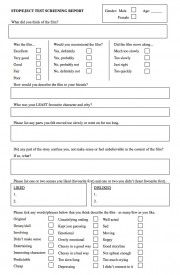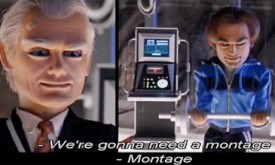Over the last few weeks, four test screenings of Stop/Eject have been held, at Hereford College of Art, at a friend’s house, at a book club and at The Rural Media Company‘s youth filmmaking group Shoot Out. Thanks to all the hosts and audiences for making these possible.

Although these screenings were all small in scale, none of them having more than a dozen attendees, it’s still a large number of screenings, certainly more than I’ve ever done before for a short or even a feature. That fact reflects the level of difficulty in editing Stop/Eject. It’s probably the toughest thing I’ve ever edited. It has very little in the way of plot, but instead relies on a single character arc to propel the film forward. So the audience is dependent on very subtle cues – facial expressions, shot juxtapositions, music – to follow what’s going on. Get one of those wrong and they won’t follow it, and they won’t engage emotionally.
The Stop/Eject screenings revealed the usual things – which scenes were unnecessary or slow, and which moments were confusing. One thing that caught me completely by surprise is that a few people thought one cameo female character was male, which gave them an utterly incorrect interpretation of that scene.

The passage of time is something else that the test audiences have struggled to pick up on; many people thought the film was set over a few days. It transpired that seasonal costumes, Christmas lights in the background of a scene and a shot of autumn leaves falling into the river were not sufficient cues. With each successive screening I added more and more cues, and people still weren’t getting it. In the end it was clear that I either had to flash up a title card (“Three months later…”) or take the advice of Team America and use a montage.
As this song suggests, montages are pretty cheesy, but to my mind they’re less of a cop-out than a title card. Plus a montage allowed me to incorporate shots from deleted scenes, and I always get a kick out of finding new and unexpected ways to use otherwise discarded footage.

The montage was inserted for the final test screening, and it must have worked, because no-one thought the events of the film happened over too short a time span.
But many of the issues that arose in the screenings were very much foreseen because they came up at script stage. Clearly they weren’t addressed adequately enough back then. One day I’ll learn that you can’t get away with ignoring any problems in your script. They will all come back to bite you in post.
Anyway, the edit as it currently stands is pretty good, and I think all involved in the project would be proud of it if I went ahead and locked it now and turned it over to the sound, music and VFX guys.
But I don’t think it’s reached its full potential. I think it could be even better, and so does Stop/Eject’s brand new executive producer, Carl Schoenfeld (who will be known to my long-term followers as the producer of The Dark Side of the Earth). So we’re now on the hunt for another editor who can take the film to the next level. This means post-production will take longer than anticipated; the film won’t be finished in 2012, but it will be the best it can possibly be, and that’s the most important thing.
Always fade out at the end of a montage / If you fade out it seems like more time has passed in a montage….
